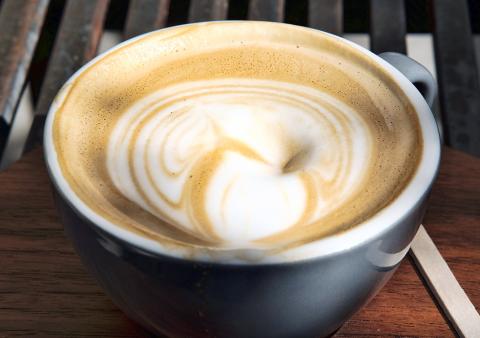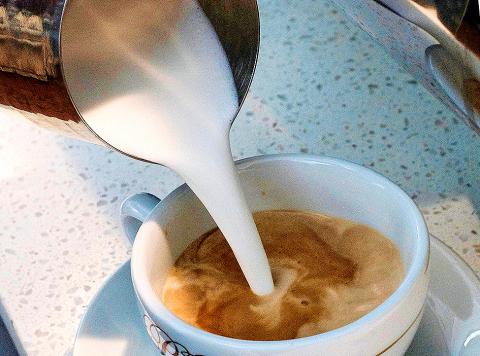Doha’s Tawar Mall looks much like any of the other unremarkable shopping centers dotted around Qatar, but tucked away in one of its corners, a tiny cultural revolution is taking place.
There you will find Flat White, Qatar’s first attempt at a hipster cafe.
Customers can buy drinks such as a V60, Aeropress or Ginger Latte, selecting coffee beans from Colombia, Tanzania or Peru, then sit and drink while perusing a book.

Photo: AP
Or they can just sip and admire the brutalist decor, all trendy bare concrete walls and dangling contemporary lighting.
In the background are the familiar sounds of drinks being prepared by baristas on machines costing US$3,500.
“We didn’t have this hipster style, this is what was missing in Qatar,” says Nasser al-Nuaimi, who co-owns Flat White with his wife Maryam.

Photo: AP
‘WE SLEEP ANYTIME’
Nuaimi, 35, is a coffee fanatic who developed a passion for the Western-style version of the drink while on his travels, especially in the US.
An international insurance executive, he discovered specialty coffee shops while on business trips — and decided to try to bring the culture back home.
He opened the first Flat White in 2012, and now there are three dotted around Doha.
“After 5 pm in Europe, people won’t drink coffee (but) have a beer. Here coffee is our passion, we drink it anytime, we sleep anytime,” he says.
The international-style coffee shop is packed with customers and notably they are almost exclusively Qatari — men wearing traditional white robes and women in black abayas — in a country where locals barely make up 10 percent of the population.
“We like the coffee, the atmosphere, the energy,” says Shamma, 19, a student drinking cappuccino and eating cheesecake with her friend Muneera, also 19.
“I have been to specialty coffee shops in London and I really liked them. This is bringing that here,” she says.
“It is becoming more of a social construct than just having a coffee.”
Seated nearby are engineers Mohammed and Jassim, both 34, who say Flat White has made them appreciate a different style of coffee.
“They are choosing beans from special places. We realized what we used to drink was not coffee,” says Mohammed, referring to more prevalent Western brands.
Arabic coffee has been a mainstay of drinking culture in the region for thousands of years.
Jassim says people still drink it widely but prefer to make it at home.
Prices are not cheap. A Chemex coffee, made in a specially designed glass flask, costs 26 Qatari riyals — around US$7.
A recent study by financial services group UBS found that a cup of coffee in Doha is the most expensive in the world, costing an average of US$6.40.
FIRST VEGAN RESTAURANT
Specialty coffee shops are springing up across Doha.
In the Qanat Quartier, an upmarket area featuring a small-scale Venice-style neighborhood, cafes with names such as “Volume” and “Artist Cafe” have popped up.
The burgeoning “hipsterism” is not confined to coffee either. A specialty breakfast cereal shop is opening, as well as Qatar’s first vegan restaurant.
And its reach extends beyond the Gulf state, with Qatari-owned coffee stores in London — in the exclusive Mayfair area, dubbed the Qatar Quarter by the British press — as well as a gastro-burger restaurant close to Qatar-owned Harrods.
But as with most things in Qatar at the moment, the food and drink sector has been affected by the year-old Gulf political crisis, in which Qatar’s neighbors have cut off all ties, accusing it of backing terrorism and being too close to Iran — charges it denies.
Qatar previously relied on its neighbors for much of its imports, and has had to radically adjust its sourcing. As part of moves to cut back the country’s reliance on imports, Qatar now reportedly wants to open its first coffee-roasting plants because of high local demand.

In the March 9 edition of the Taipei Times a piece by Ninon Godefroy ran with the headine “The quiet, gentle rhythm of Taiwan.” It started with the line “Taiwan is a small, humble place. There is no Eiffel Tower, no pyramids — no singular attraction that draws the world’s attention.” I laughed out loud at that. This was out of no disrespect for the author or the piece, which made some interesting analogies and good points about how both Din Tai Fung’s and Taiwan Semiconductor Manufacturing Co’s (TSMC, 台積電) meticulous attention to detail and quality are not quite up to

April 21 to April 27 Hsieh Er’s (謝娥) political fortunes were rising fast after she got out of jail and joined the Chinese Nationalist Party (KMT) in December 1945. Not only did she hold key positions in various committees, she was elected the only woman on the Taipei City Council and headed to Nanjing in 1946 as the sole Taiwanese female representative to the National Constituent Assembly. With the support of first lady Soong May-ling (宋美齡), she started the Taipei Women’s Association and Taiwan Provincial Women’s Association, where she

Chinese Nationalist Party (KMT) Chairman Eric Chu (朱立倫) hatched a bold plan to charge forward and seize the initiative when he held a protest in front of the Taipei City Prosecutors’ Office. Though risky, because illegal, its success would help tackle at least six problems facing both himself and the KMT. What he did not see coming was Taipei Mayor Chiang Wan-an (將萬安) tripping him up out of the gate. In spite of Chu being the most consequential and successful KMT chairman since the early 2010s — arguably saving the party from financial ruin and restoring its electoral viability —

It is one of the more remarkable facts of Taiwan history that it was never occupied or claimed by any of the numerous kingdoms of southern China — Han or otherwise — that lay just across the water from it. None of their brilliant ministers ever discovered that Taiwan was a “core interest” of the state whose annexation was “inevitable.” As Paul Kua notes in an excellent monograph laying out how the Portuguese gave Taiwan the name “Formosa,” the first Europeans to express an interest in occupying Taiwan were the Spanish. Tonio Andrade in his seminal work, How Taiwan Became Chinese,